A Deep Dive Into Hideaki Anno’s Mind-blowing, Groundbreaking Neon Genesis Evangelion
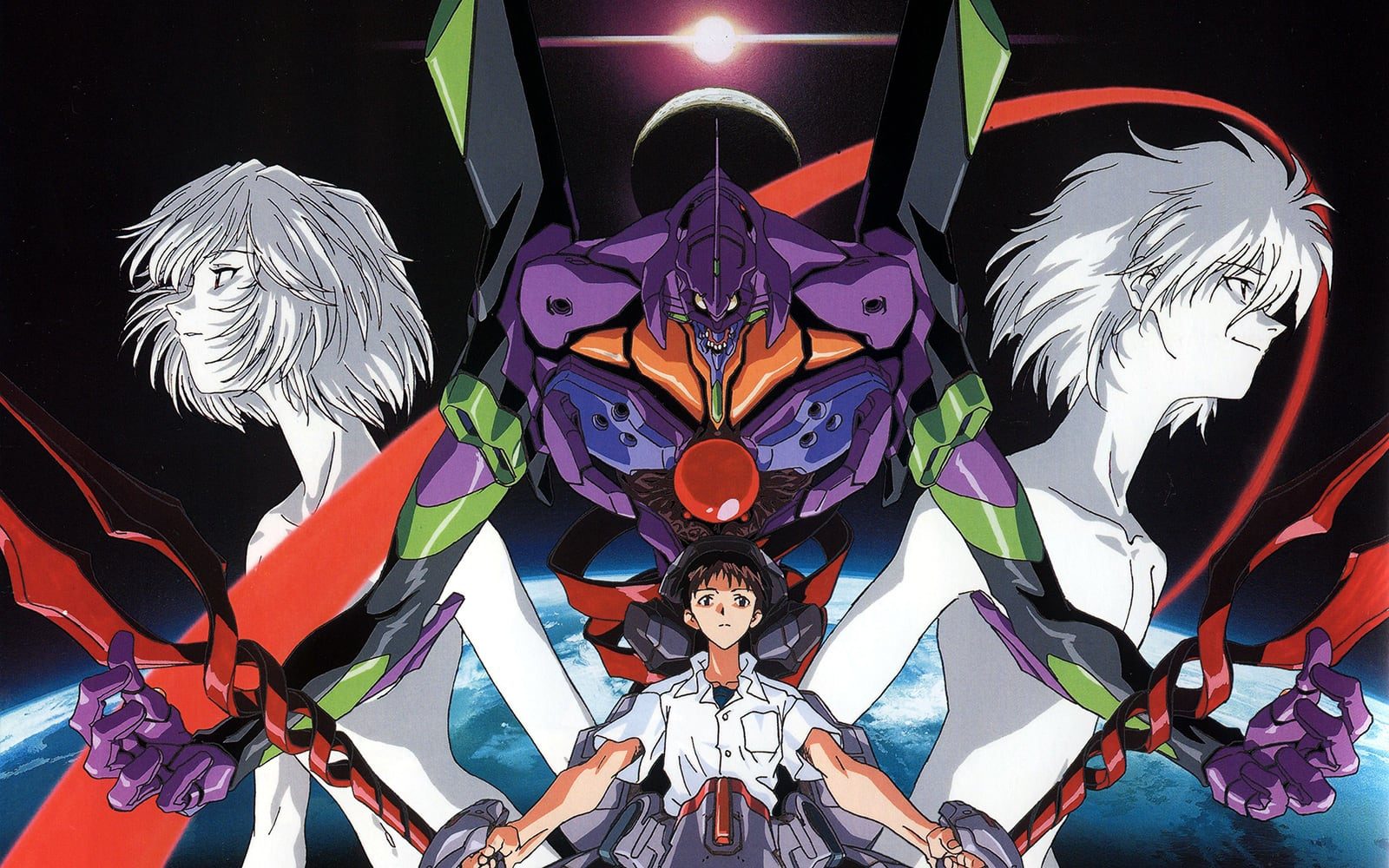
On June 21, Netflix will begin streaming Neon Genesis Evangelion, as well as two follow-up movies, Death & Rebirth and The End of Evangelion. Shortly after Netflix’s announcement dropped last November, the internet’s nerdier areas were filled with folks discussing the news and, of course, the Evangelion franchise as a whole.
Netflix’s trailer calls Evangelion “one of the most beloved, influential, critically acclaimed anime of all time,” which is high praise, indeed. But why the fuss? What makes Evangelion so special, and why has it been, by turns, so fascinating and frustrating for so many viewers for more than two decades?
To explore Evangelion’s legacy, I’ve put together this deep dive into the franchise, from its spin-offs to the themes and various controversies that have surrounded it for the last 24 years, and on to its larger impact on the anime medium.
- Neon Genesis Evangelion: The Original Series
- Turning Evangelion Up to 11 (And Then Some)
- Evangelion vs. Otaku Culture
- Rebuilding Evangelion
- Finding Religion in Evangelion
- Evangelion’s Ongoing Legacy
- Evangelion Resources
Needless to say, the following is packed with spoilers. Consider yourself warned.
Neon Genesis Evangelion: The Original Series
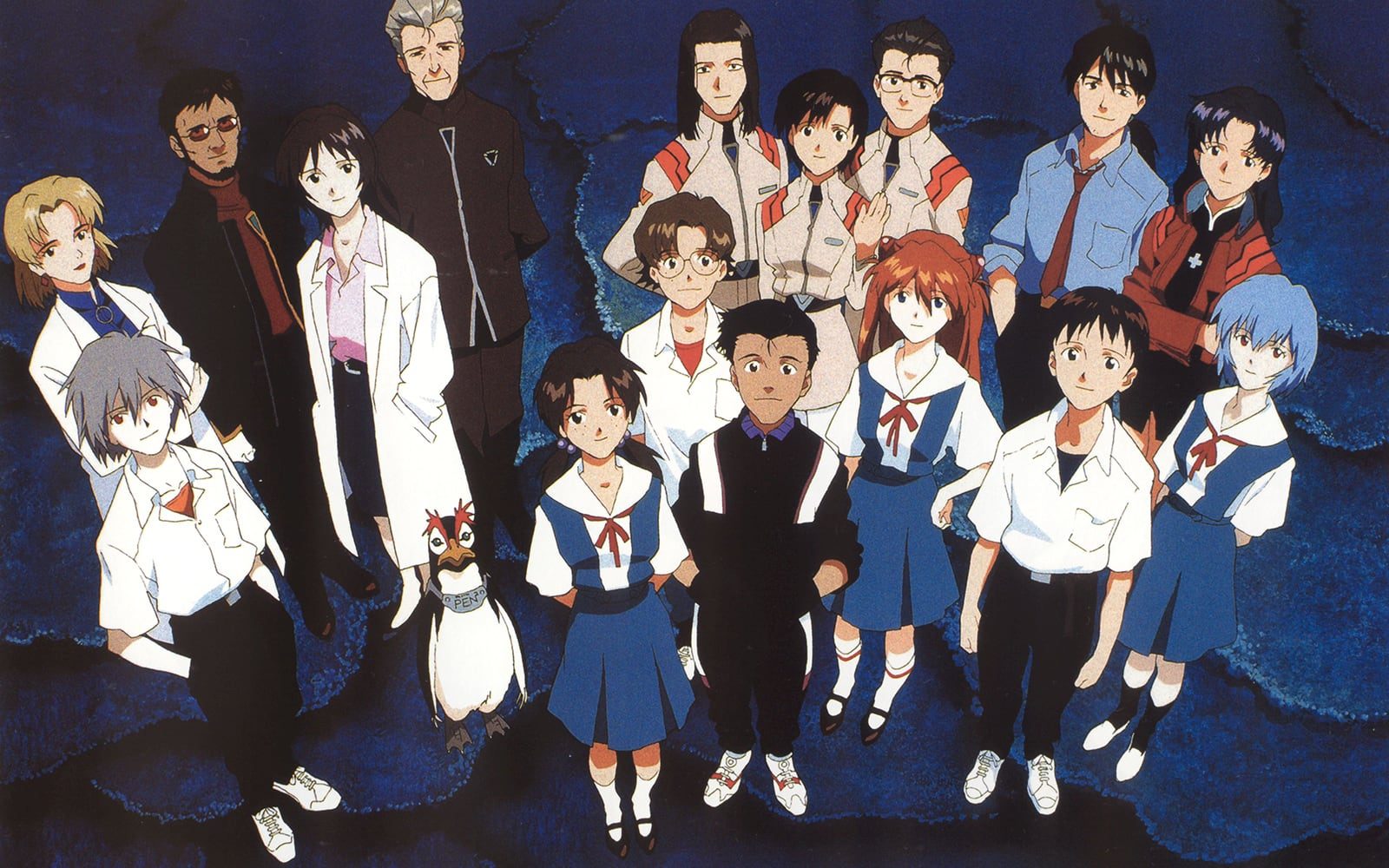
The original Neon Genesis Evangelion series — which consists of 26 episodes that aired on Japanese TV in 1995 – 1996 — is set in the year 2015, fifteen years after a cataclysmic event called the “Second Impact” nearly destroyed Earth, killing billions and permanently altering the climate. After years of war, suffering, and rebuilding, humanity is faced with a new threat: strange, alien creatures called “Angels” that can only be stopped by a handful of giant robots, the titular “Evangelion.”
Overseeing the Evangelion is an organization called Nerv, which is commanded by the enigmatic Gendo Ikari. When Evangelion begins, Gendo’s estranged fourteen-year-old son Shinji has just arrived at Nerv HQ in the fortress city of Tokyo-3. Shinji thinks Gendo has brought him there for a reunion but he discovers the brutal truth when an Angel attacks: Evangelion can only be piloted by teenagers born after the Second Impact and Gendo intends to make Shinji the next Evangelion pilot.
For its first third or so, Evangelion follows a “monster of the week” format. A new Angel arrives on Earth to threaten humanity, Shinji and the rest of Nerv race to find a winning strategy, and the Angel is finally destroyed in a big climax, saving humanity once again. But Evangelion eventually abandons that format, particularly in how it starts to explore its characters psychologically.
Shinji shows signs of being a talented pilot, and he takes to it as a way to earn his father’s approval, but the constant violence and death become increasingly traumatic. That, combined with his anxiety and fear of failure and separation (due to Gendo’s distance), makes Shinji far less charismatic than the typical anime hero. In fact, all of Evangelion’s main characters are deeply flawed and broken. As Evangelion continues, it’s hard to see them as heroes even as they fight to prevent the “Third Impact,” which will destroy the planet. For example:
- Asuka Langley Soryu may be a better pilot than Shinji, but she’s reeling from her mother’s insanity and suicide. Subsequently, she hides her pain behind pride and arrogance (which is mainly directed at Shinji).
- The other pilot, Rei Ayanami, lives in squalor and is so emotionally null that she’s essentially a cypher.
- Shinji’s guardian, Misato Katsuragi, is a respected Nerv officer who struggles with survivor’s guilt (her father sacrificed himself to save her during Second Impact), relationship woes, and alcoholism.
- Gendo seems indifferent to everything, even his own son. Shinji et al. seem like little more than pawns in his own mysterious plans but there are signs that he still mourns his wife Yui, who died in an Evangelion-related accident after Shinji’s birth.
These personal crises make for grim viewing. As Susan Napier wrote in Anime: From Akira to Princess Mononoke (2001):
[D]espite the requisite and truly chilling scenes of combat with the Angels, the series also contains a greater number of scenes in which the characters bicker and insult each other or else engage in intense brooding about their angst-ridden childhoods and their equally dysfunctional and disappointing parents. Far from being potential young heroes, each character is burdened by the memory of such transgressive episodes as parental abandonment and sexual betrayal.
Evangelion is certainly action-packed, but to its credit, doesn’t glorify the violence; nor does it shy away from the personal and psychological effects of unending (and apparently, hopeless) warfare. Shinji takes the brunt of this damage, and grows, by turns, increasingly pitiful and pitiable. As if to parallel this, Evangelion itself grows more bizarre, culminating in a pair of final episodes that occur inside Shinji’s fractured mind.
It’s ultimately revealed that a mysterious group called Seele — the true force behind Nerv, the Evangelion, and many of the series’ events — has unleashed the “Human Instrumentality Project,” a secret plan to combine everyone’s souls into one entity, thus elevating humanity to a higher plane of existence free from pain and suffering. As Shinji becomes aware of this, he struggles with his anger, sense of failure, and self-loathing, comes to a place of acceptance, and is finally able to be at peace with both himself and others.
This is where the original series ended. (Believe it or not, but the above a simplification of the series’ events.) But plenty more was to come; Evangelion creator Hideaki Anno wasn’t finished with his audience yet.
Turning Evangelion Up to 11 (And Then Some)
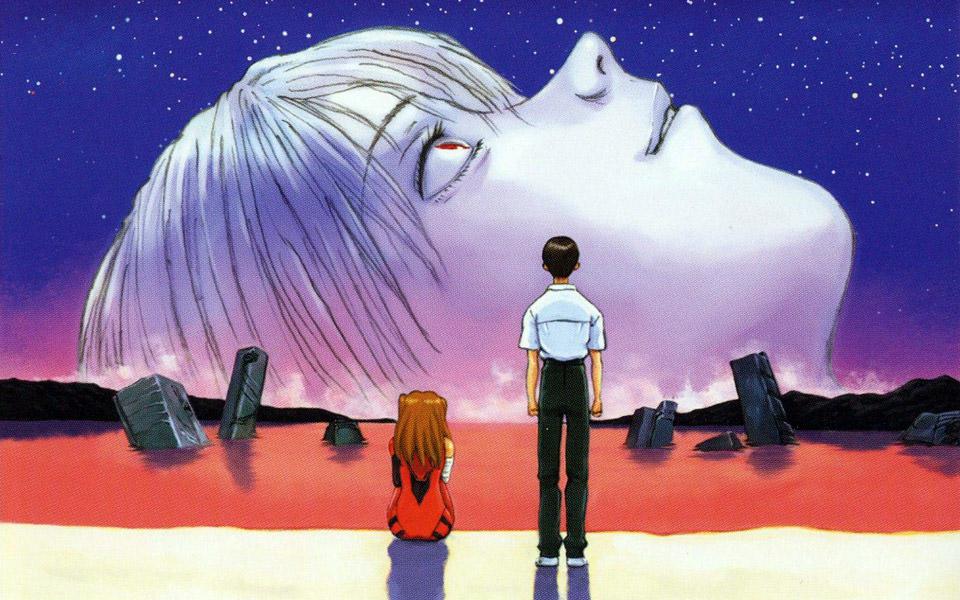
While the Evangelion series was generally considered a success, its ending was controversial. Some praised the unorthodox ending while others — who were perhaps hoping that Evangelion would end in a more straightforward and action-packed fashion as befitting a “giant robot” title — reacted with confusion and frustration. Anno and Gainax, the studio that produced Evangelion, even received death threats from some particularly irate fans. (And you thought fan entitlement was a recent phenomenon.)
And so Anno and Gainax released two Evangelion movies in 1997 — Neon Genesis Evangelion: Death & Rebirth and The End of Evangelion — that would give fans what they wanted, but with a twist.
The first two-thirds of Death & Rebirth whittles down the series’ first 24 episodes into an hour-long clip show that breezes by at breakneck speed, providing an overview of the series that becomes something akin to a fever dream. And when that onslaught is over, well, that’s when all hell breaks loose.
Death & Rebirth’s final segment and the whole of End of Evangelion eschews the series’ ending, with its dive into Shinji’s psyche and ultimately upbeat (if weird) resolution. Instead, viewers are given an intense, twisted, and apocalyptic finale that’s nevertheless full of action — and feels like Anno flipping a giant middle finger at the haters. (As an added jab at angry fans, shots of the aforementioned death threats are included in one of the movie’s more abstract sequences.)
To name but a few of their strange and disturbing images, the two Evangelion movies include scenes of:
- A broken, despondent Shinji masturbating over a comatose Asuka
- Seele launching a bloody attack on Nerv HQ that’s rendered in graphic detail
- Asuka and her Evangelion being dismembered and consumed by Seele’s own demonic-looking Evangelion, who later kill themselves in an orgiastic fashion
- An Evangelion crucifixion
- The human race being turned into primordial goo as everyone’s souls are collected by a giant nude version of Rei (who turns out to be an Angel herself)
The End of Evangelion concludes with the grim sight of Shinji and Asuka alone on a ruined Earth, apparently cut off from the rest of humanity after Shinji rejected Seele’s Human Instrumentality Project (as opposed to his acceptance in the original TV series). Consumed with sorrow and self-hatred, Shinji begins strangling the still-unconscious Asuka before breaking down in tears. She awakens to the sound of his sobs and utters the movie’s final line: “How disgusting.”
Though it was a box office success and won several awards, including the 1997 Animage Anime Grand Prix, The End of Evangelion was also criticized for being incoherent and over-the-top. And not surprisingly, it generated its own fair share of controversy, particularly concerning Shinji’s treatment of Asuka (e.g., the masturbation scene).
However, there’s more going on in The End of Evangelion than mere misogyny; it’s pure, unadulterated misanthropy. As one critic wrote:
The film End of Evangelion was a dark, brutal, psychedelic orgy of sex and violence that culminated in the mass extinction of humanity set to an optimistic J-pop song with lyrics about suicide. The themes of the television show criticizing the audience for being spineless and lost in a fantasy world were cranked up to eleven, as the protagonist Shinji basically watches everybody die around him due to his refusal to make any effort whatsoever to engage with other people.
There’s no denying that The End of Evangelion is filled with an almost ridiculous amount of “end of the world” spectacle. Critic Keith Uhlich might’ve said it best when he described The End of Evangelion as “an end-times free-for-all that mixes Christian symbology, Jewish mysticism, sexual paranoia and teenage angst into a searing apocalyptic stew.”
Evangelion vs. Otaku Culture
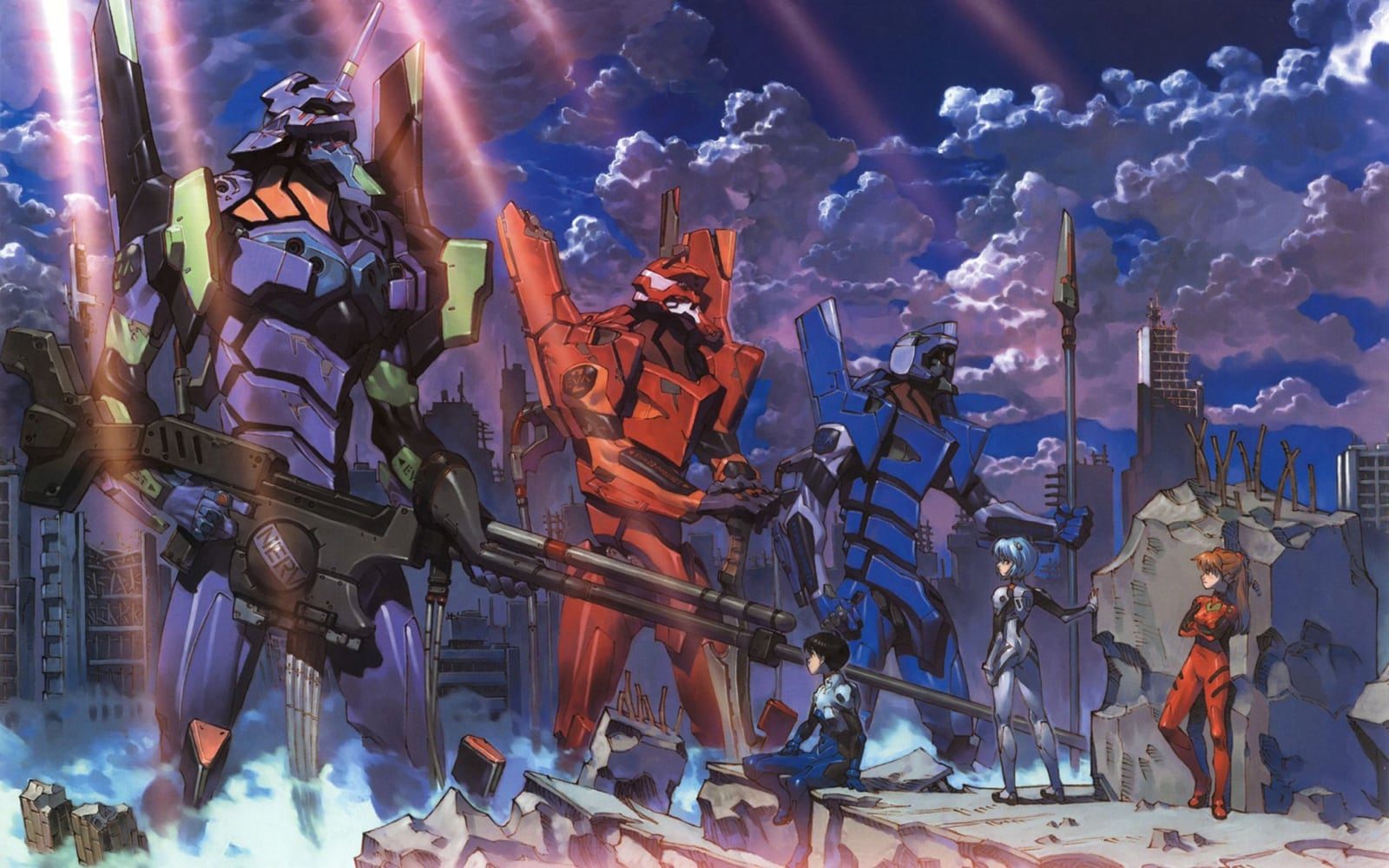
What could’ve led Hideaki Anno to create something as grim as The End of Evangelion, or put his characters through the ringer in the original series? Any attempt to answer such questions or examine Evangelion’s deeper themes must begin by recognizing that prior to creating Evangelion, Anno suffered from years of severe depression.
I don’t think it’s too much of a stretch to say that Evangelion was, in part, Anno’s attempt to process and overcome this depression — hence the series’ increasingly psychoanalytical approach (which also drew from Anno’s growing interest in psychology and mental illness).
Looking beyond its creator’s issues, though, Evangelion can also be seen as a criticism of the obsessive fan (or otaku) culture that has long surrounded anime — a culture that, ironically, Anno and Gainax had done much to celebrate in previous titles like the “Daicon” animated shorts and Otaku no Video and that they were relying on for Evangelion’s success.
Evangelion initially seems like the ultimate otaku wish fulfillment, i.e., a young boy is destined to save the world thanks to his awesome robot piloting skills. This idea manifests itself clearly in Evangelion’s opening theme, an upbeat J-pop number by Yoko Takahashi titled “A Cruel Angel’s Thesis” that includes lyrics like “Young boy, who shines brighter than anyone else/Rise to become a legend” — lyrics that become increasingly ironic as the series progresses.
As Evangelion progresses, it deliberately and thoroughly deconstructs various otaku tropes:
- Instead of becoming a brave hero, Shinji grows increasingly weak, pitiable, and anti-social. He shies away from relationships because they’re too difficult and spends his free time holed up in his room à la hikikomori (individuals who refuse to leave their rooms and instead, shut themselves off from broader Japanese society).
- The awesome giant robot that he pilots is, in fact, a living creature that can transform into a horrific monster capable of flying into beserker rages during which it literally devours opponents.
- And speaking of those giant robots, the Evangelions’ design is decidedly un-robotic (especially when compared to, say, the Gundam and Macross franchises). Rather, Evangelion look as much like insect/lizard hybrids as anything else. (The horrific God Warrior from Hayao Miyazaki’s Nausicaä of the Valley of the Wind, on which Anno worked as an animator, is probably the Evangelions’ most obvious precursor.)
- The glorious action and combat serves only to further damage and traumatize everyone involved (even the audience).
- The Evangelions’ mission to save Earth is ultimately revealed to be far stranger and more sinister than could ever have been expected.
In Napier’s analysis of Evangelion’s deconstruction of the mecha anime genre, she notes that while it “showcases brilliant combat scenes of mecha-on-mecha confrontations, these scenes take place within a bleak context of seriously dysfunctional family, work, and sexual relationships that is permeated with a mystical and apocalyptic philosophy and interwoven with surreal graphic imagery.”
When asked back in 2004 why Evangelion included sex and violence, Anno replied that such content was necessary “to understand real life.” More: “[Anno] felt that children should be exposed early to the realities of life so that they do not grow up weak and sheltered and so that they will become immune to some of the harsh situations they will eventually experience.”
Those sentiments may seem misanthropic, but they make a bit more sense in light of Anno’s statements in this 2007 Atlantic feature about suicide and Japan that discusses at length Evangelion’s impact on Japanese culture, and specifically otaku culture. This was Anno’s grim assessment of his homeland:
Japan lost the war to the Americans… Since that time, the education we received is not one that creates adults. Even for us, people in their 40s, and for the generation older than me, in their 50s and 60s, there’s no reasonable model of what an adult should be like…
…I don’t see any adults here in Japan. The fact that you see salarymen reading manga and pornography on the trains and being unafraid, unashamed or anything, is something you wouldn’t have seen 30 years ago, with people who grew up under a different system of government. They would have been far too embarrassed to open a book of cartoons or dirty pictures on a train. But that’s what we have now in Japan. We are a country of children.
Otaku culture is often accused of a disturbing childishness, be it the slavish nostalgia for childhood icons (of which Evangelion could be counted) or the adoration and even fetishization of infantilized characters (e.g., the moe genre). Evangelion starts off in a similar manner, with Shinji expressing all sorts of childlike awe at what he sees (e.g., Nerv’s massive underground base), only to quickly and thoroughly disabuse its characters — and by extension, its audience — of any such notions.
There’s something almost gleefully nihilistic about this deconstruction — Napier describes Evangelion as “overstuffed with images of apocalyptic destruction” — but I’d argue that any nihilism isn’t simply there for its own sake.
Rather, I think it’s more analogous to Flannery O’Connor’s use of shocking imagery (“to the hard of hearing you shout, and for the almost-blind you draw large and startling figures”). In other words, Evangelion was intended as a wake-up call for people stuck in otaku fantasies and therefore incapable of, or uninterested in, interacting with the world and others in meaningful ways.
Rebuilding Evangelion
Although Evangelion is a grim series with complex, subversive themes that deconstruct the tropes that have long dominated anime, Gainax has turned it into a massive cash cow that they’ve milked every way possible. As a result, it’s one of the most profitable media franchises of all time, with $16 billion in revenue to date. (That makes it more valuable than The Simpsons, Avengers, or Frozen franchises.)
That money has come from anime and manga sales, of course, but also from karaoke CDs, video games, amusement parks, and most of all, the sale of Evangelion-themed pachinko gambling devices. Subsequently, it’s tempting to see anything Evangelion-related — be it an upcoming crossover with Godzilla, these scissors and guitar accessories, or this cleverly themed bar/restaurant — as just another shameless Gainax cash grab.
Which brings us to Rebuild of Evangelion. Announced in 2007 by Anno himself, Rebuild is a series of four movies that aims to recreate Evangelion with modern techniques and technology while also updating its storyline with new elements, characters, and even a new ending. What sets Rebuild apart from all the other Evangelion-related items is that it’s not a Gainax production. Instead, Anno started a new studio called Khara specifically for Rebuild and reunited with key designers and artists from the original series.
So far, only the first three Rebuild films have been released:
- Evangelion: 1.0 You Are (Not) Alone (2007)
- Evangelion: 2.0 You Can (Not) Advance (2009)
- Evangelion: 3.0 You Can (Not) Redo (2012)
Evangelion: 1.0 follows the original series fairly closely, with Shinji’s arrival in Tokyo-3, his introduction to the Evangelion, and his first Angel battles. But Evangelion: 2.0 quickly and markedly diverges from the original storyline. New characters are introduced (e.g., a new Evangelion pilot named Mari Makinami who is inexplicably older than fourteen) while other characters’ roles are radically changed. Shinji becomes even more of an anti-hero; he doesn’t simply fail to prevent the world’s end, but actively — if unwittingly — brings about the “Third Impact.”
Evangelion: 3.0 then jumps ahead another fourteen years: Shinji has become something akin to a war criminal, and is on the run from former friends and allies (who are now fighting against Nerv). He reunites with Gendo and joins up with another Evangelion pilot (the enigmatic Kaworu) who is much more than he seems. Oh, and Shinji screws up again and starts the “Fourth Impact” — ’cause Shinji’s always gonna Shinji.
In other words, if you thought the original Evangelion storyline was convoluted, you probably ain’t seen nothing yet.
Rebuild of Evangelion won’t be finished for another year (at least). The tetralogy has been plagued by numerous delays, and the final film’s production was halted by Anno’s recurring depression (or as he put it, “the natural result of having spent six years grinding down my soul making Eva again”). In order to take a break from Evangelion, Anno wrote and directed 2016’s acclaimed Shin Godzilla (which, in typical Anno fashion, is a deconstruction of the typical Godzilla movie). But work has since re-commenced on the final Rebuild film, Evangelion: 3.0+1.0, with a planned release date some time in 2020.
When Anno announced Rebuild, he made some pretty ambitious statements concerning the new movies, including this bit:
Although it seems obvious, we aim to create a form of entertainment that anyone can look forward to; one that people who have never seen Evangelion can easily adjust to, one that can engage audiences as a movie for theatres, and one that produces a new understanding of the world.
It remains to be seen whether or not Rebuild of Evangelion lives up to Anno’s goal of being a more accessible Evangelion that “produces a new understanding of the world.”
Finding Religion in Evangelion
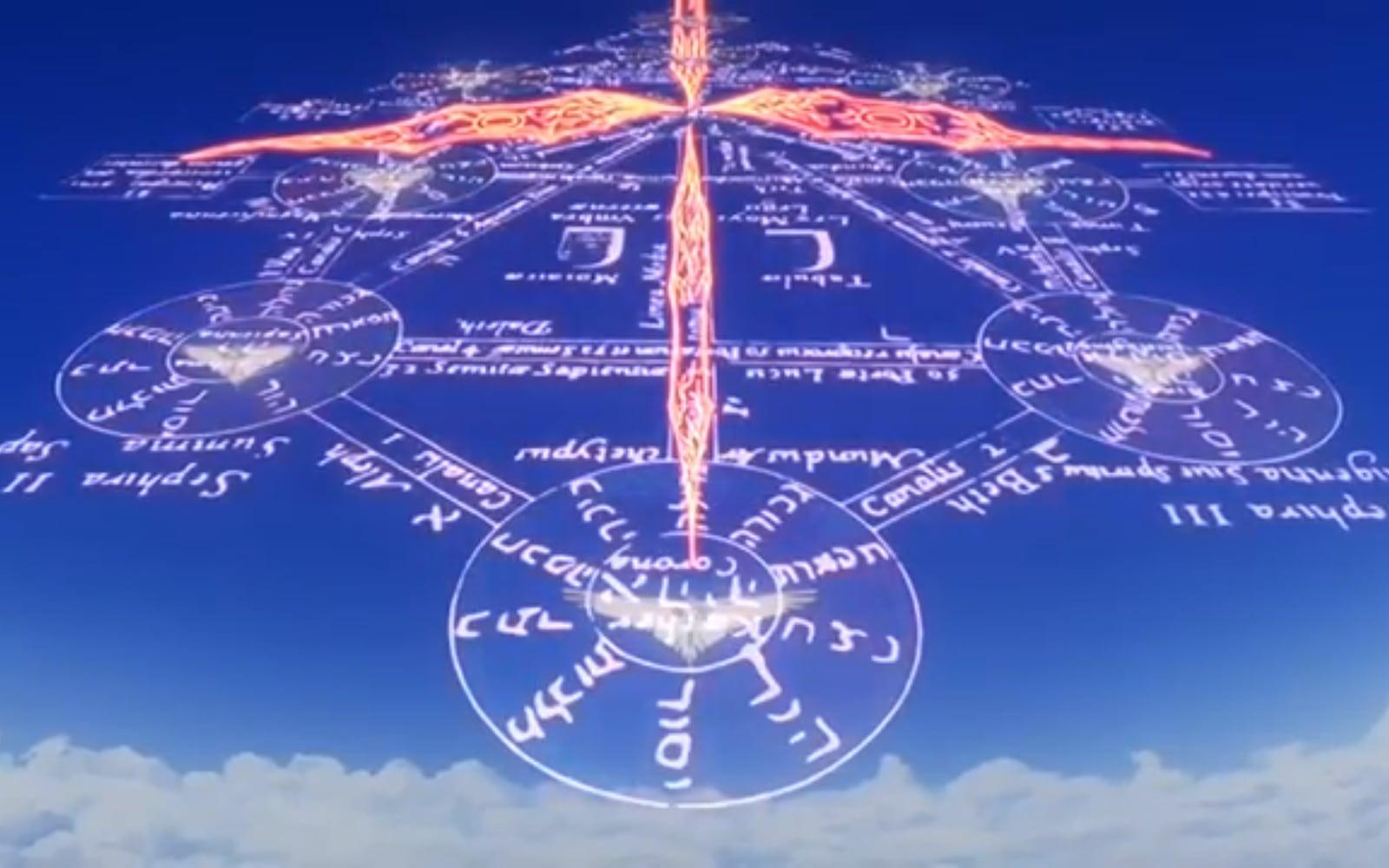
One of the most intriguing aspects of Evangelion is its labyrinthian internal mythology. And that’s largely due to its frequent use of Christian, Kabbalistic, and Gnostic imagery. Some references, like the crucifixion and tree of life imagery, are obvious, but many others are less so and/or are given new spins:
- The franchise’s Japanese title, Shinseiki Evangerion, can be translated as “The Gospel of the New Century.”
- Several of the Angels’ names, characteristics, and attacks (e.g., Sachiel, Ramiel, Sandalphon, Sahaquiel, Leliel, Zeruel) were inspired by esoteric strains of Christianity and Judaism.
- Important plot devices include the Lance of Longinus, the Chamber of Guf, the Dead Sea Scrolls, and the fruits of Knowledge and Life.
- Nerv’s super-computers are named after the three Magi that visited the newborn Christ.
- Seele was inspired by the Essenes, an ascetic Jewish sect long associated with the Dead Sea Scrolls, and its seven-eyed logo is a reference to the Book of Revelation.
(In addition to esoteric religious references, Evangelion also references esoteric scientific concepts like the Dirac sea and organic computers.)
If you’re coming to Evangelion from a western cultural context steeped in Judeo-Christian concepts, it’s difficult not to wonder what this all means. Were Anno and Gainax trying to promote some sort of religious philosophy. Was Evangelion a religious commentary/critique? The truth, as it turns out, was far more secular: Evangelion’s religiosity was essentially a marketing tactic.
In a 2001 interview, assistant director Kazuya Tsurumaki explained the franchise’s use of religious imagery:
There are a lot of giant robot shows in Japan, and we did want our story to have a religious theme to help distinguish us. Because Christianity is an uncommon religion in Japan we thought it would be mysterious. None of the staff who worked on Eva are Christians. There is no actual Christian meaning to the show, we just thought the visual symbols of Christianity look cool. If we had known the show would get distributed in the US and Europe we might have rethought that choice.
To that end, the decision to use religious imagery was a success. Though references to Christianity are quite common in anime, it’s difficult to think of too many other titles that do so with such abandon, or in such an interesting fashion.
The frequent — and decidedly non-orthodox — usage of strange and obscure religious imagery may be careless and lacking in any systematic approach. At the same time, it’s so darn weird and over-the-top that it becomes strangely compelling, adds an otherworldliness to the series’ world-building, and invests its apocalyptic scenes with a real sense of, well, the apocalypse. To this day, Anno et al.‘s arbitrary marketing decision continues to set Evangelion apart from its peers and descendants.
Evangelion’s Ongoing Legacy
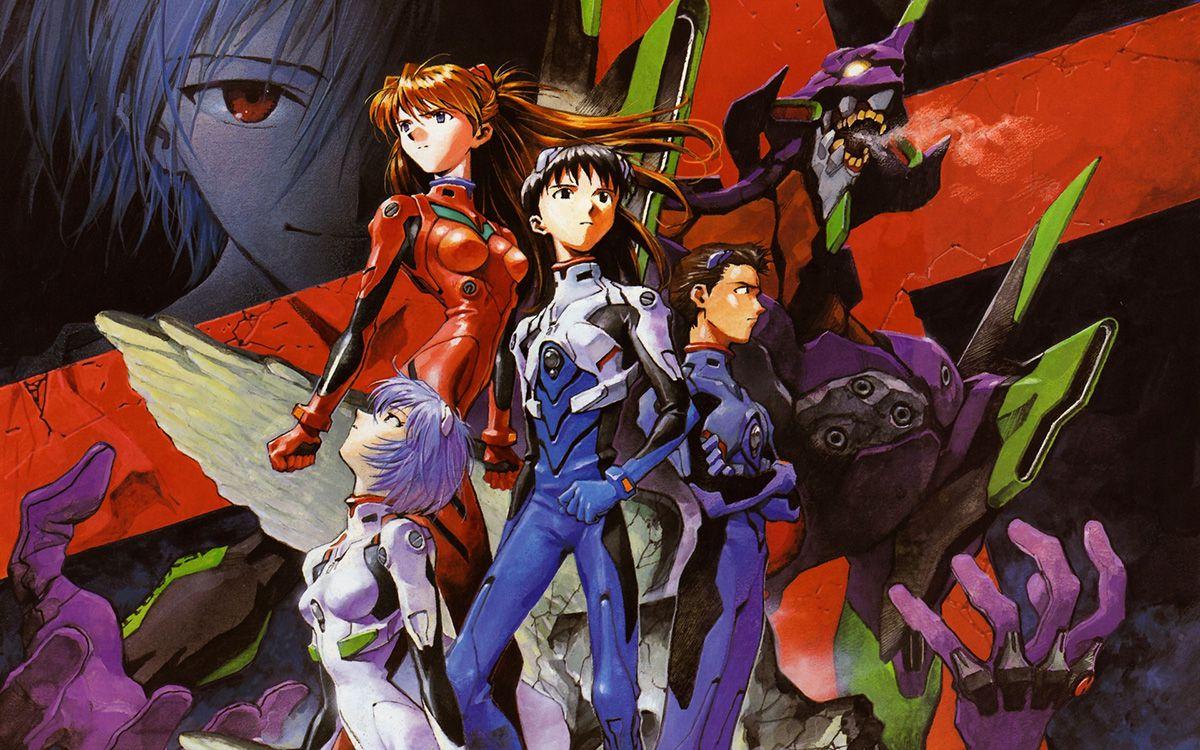
When Evangelion arrived on Japanese television, the anime market was stagnant. Evangelion injected some much-needed new blood into that market. It represented a new approach to anime production inspired by live-action filmmaking, and was more auteur-like (as evidenced by Anno drawing inspiration from his own mental issues) and creator-controlled.
Suffice to say, any anime series that combines giant robots with dense, dramatic storylines, esoteric (and convoluted) mythologies, and troubled characters — e.g., RahXephon, Argento Soma, Gasaraki — now owes some debt to Evangelion (and will likely have to suffer critics’ comparisons to Anno’s work).
But even a celebrated anime filmmaker like Makoto Shinkai, whose Your Name is the most successful anime film of all time (and most definitely not a “giant robot” title), has acknowledged a debt to Evangelion and its influential approach to anime storytelling.
People have been debating and discussing Neon Genesis Evangelion for more than two decades, ever since that first episode aired on TV Tokyo on October 4, 1995. Perhaps the greatest genius of Evangelion is that it provides enough of a storyline, with dense narratives and complex characters, to draw viewers in while also leaving enough that’s ambiguous and unexplained so that many find it impossible to stop thinking about it. (It also doesn’t hurt that several levels of Evangelion canon exist, which serves only to further fuel any discussion.)
Unfortunately, Evangelion titles have been largely unavailable here in the States following the dissolution or dormancy of ADV Films and Manga Entertainment within the last decade or so. As such, it was a pleasant surprise to see Netflix’s announcement last year, especially given the streaming giant’s apparent interest in only producing and streaming new and original anime.
Between Netflix’s upcoming streaming and the (hopefully) soon-to-be-completed Rebuild of Evangelion, Neon Genesis Evangelion’s vaunted position in the annals of anime won’t be challenged any time soon. Indeed, a whole new group of fans may very well find themselves caught up in the existential saga of Shinji, Asuka, Gendo, Nerv, Seele, et al. And suffice to say that when they do, they’ll find plenty to ponder and discuss for days to come.
Evangelion Resources
It shouldn’t be too surprising that there exist numerous Evangelion-related resources online, which can help with parsing its stranger and more obscure aspects (or with writing a really long blog post about them). Some of the best ones include EvaWiki, The Evangelion Otaku Page, and The Nerv Achives.
They all contain a wealth of information pulled from numerous sources, including screenplays, theatrical program books, and production materials, and given the franchise’s elaborate mythology, you can easily get lost down an Evangelion rabbit hole if you’re not careful.